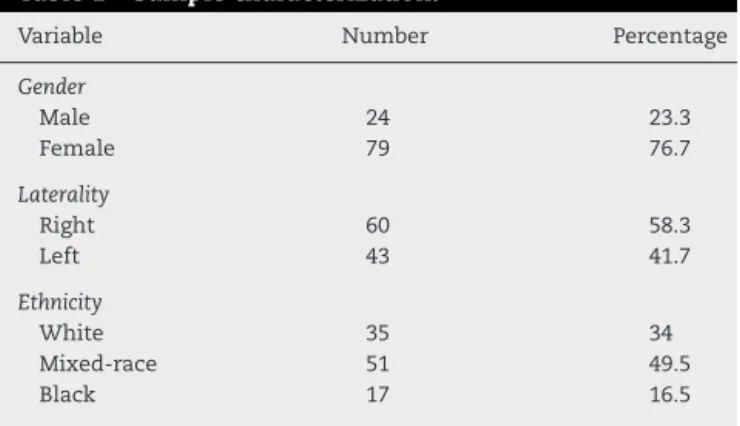SOCIEDADE BRASILEIRA DE ORTOPEDIA E TRAUMATOLOGIA
w w w . r b o . o r g . b r
Original
article
Evaluation
of
serum
levels
of
C-reactive
protein
after
total
knee
arthroplasty
夽
João
Maurício
Barretto
∗,
Fabrício
Bolpato
Loures,
Rodrigo
Sattamini
Pires
e
Albuquerque,
Filipe
das
Neves
Bezerra,
Rafael
Vinagre
Faro,
Naasson
Trindade
Cavanellas
InstitutoNacionaldeTraumatologiaeOrtopedia(Into),RiodeJaneiro,RJ,Brazil
a
r
t
i
c
l
e
i
n
f
o
Articlehistory:
Received2March2016 Accepted17May2016 Availableonline6March2017
Keywords:
C-reactiveprotein PCR
Knee Osteoarthritis Arthroplasty
a
b
s
t
r
a
c
t
Objective:ToevaluatethebehaviorofC-reactiveprotein(CRP)levelsinthefirstthreeweeks aftertotalkneearthroplasty(TKA)anddefinethefactorsrelatedtoitsvariation.
Methods:WeevaluatedtheCRPvaluesin103patientsundergoingprimaryTKA.SerumCRP wasmeasuredonthedaybeforesurgery,andonthethirdandtwenty-firstdaysafterthe procedure.
Results:PCRshowedsuddenincreaseonthethirddayaftersurgery,reachingthemeanvalue of111.9mg/L,median75.9mg/L.Onlyone-thirdofthepatientsreturnedtonormallevelsin thethirdweek.Intheimmediatepostoperativeperiod,CRPwasnotcorrelatedwithbody massindex(BMI),age,gender,bloodtransfusion,orcomplications.
Conclusion:SerumCRPremainshighinthethirdweekafterTKAinmostpatients,andthis changeisprimarilyrelatedtosurgicaltrauma.
©2017PublishedbyElsevierEditoraLtda.onbehalfofSociedadeBrasileiradeOrtopedia eTraumatologia.ThisisanopenaccessarticleundertheCCBY-NC-NDlicense(http:// creativecommons.org/licenses/by-nc-nd/4.0/).
Avaliac¸ão
dos
níveis
séricos
da
proteína
C
-reativa
após
artroplastia
total
do
joelho
Palavras-chave:
ProteínaC-reativa PCR
Joelho Osteoartrite Artroplastia
r
e
s
u
m
o
Objetivo:AvaliarocomportamentodaproteínaC-reativa(PCR)séricanastrêsprimeiras sem-anasapósartroplastiatotaldojoelho(ATJ)edefinirosfatoresrelacionadosasuavariac¸ão.
Métodos:ForamavaliadososvaloresdaPCRem103pacientessubmetidosàATJprimária.A PCRséricafoidosadanavésperadacirurgia,noterceiroeno21◦diaapósoprocedimento.
Resultados:APCR apresentou elevac¸ão súbitano terceirodia apósa cirurgia, atingiuo valormédiode111.9mg/L,commedianade75,9mg/L.Somenteumterc¸odospacientes
夽
StudyconductedattheInstitutoNacionaldeTraumatologiaeOrtopedia(Into),CentrodeCirurgiadoJoelho,RiodeJaneiro,RJ,Brazil.
∗ Correspondingauthor.
E-mail:joao.barretto1@gmail.com(J.M.Barretto).
http://dx.doi.org/10.1016/j.rboe.2016.05.009
apresentounormalizac¸ãonaterceirasemana.Nopós-operatórioimediato,nãofoi encon-tradacorrelac¸ãodaPCRcomíndicedemassacorporal(IMC),idade,gênero,hemotransfusão oucomplicac¸õesdospacientes.
Conclusão: APCRséricapermaneceelevadanaterceirasemanaapósATJnamaioriados pacienteseessaalterac¸ãoestárelacionadaessencialmenteaotraumacirúrgico.
©2017PublicadoporElsevierEditoraLtda.emnomedeSociedadeBrasileirade OrtopediaeTraumatologia.Este ´eumartigoOpenAccesssobumalicenc¸aCCBY-NC-ND (http://creativecommons.org/licenses/by-nc-nd/4.0/).
Introduction
Osteoarthritis(OA)istheleadingcauseofmusculoskeletal dis-abilityworldwide,1andthemainphysicallimitationfactorin
theelderlypopulation.2Thisserious publichealthproblem
affectsapproximately12.4millionBrazilians.3Dueto
anatom-icalandbiomechanicalfactors,themostcommonlyaffected jointistheknee.1
Theincreasedlifeexpectancyanddesireforgreater activ-ityhaveexponentiallyincreasedthedemandfortotalknee arthroplasty (TKA).4 It represents one of the most
suc-cessful orthopedic procedures of the century. Despite the successofTKA,post-operativeinfectionremainsa devastat-ingcomplication.5Earlydiagnosisisdifficult,asthesignsof
physicalexamination and serological markers can present alterationsduetosurgicaltrauma.6
C-reactiveprotein(CRP)isanexampleofanacute-phase protein.Itissynthesized mainlybythe hepatocyte,andits functionistoactivatethecomplementsystemthroughthe classicalpathway.7Afterinfectiousorinflammatorystimuli,
serumCRPlevelsmayriseabruptly,reachingupto1000times thebaselinevaluein48h.8
Thissubstancehasbeenusedinclinicalpracticeforover 70yearsasamarkerofinfectionand/orinflammation,butits serumvaluesanditsresponsetostimulivarywidely,andthe factorsassociatedwiththisoscillationarestilllittleknown.7
TheevaluationofserumCRPformsapartofthe propedeu-ticsforthediagnosisofperiprostheticinfection.9Thetesthas
highsensitivityandlowspecificity,10andmaybeinfluenced
byfactorssuchasage,gender,comorbidities,9andbodymass
index,11inadditiontothesurgicaltrauma.
ThisstudyaimedtoassessthebehaviorofserumCRPin thefirstthreeweeksafterTKAand toestablish thefactors relatedtoitsvariation.
Material
and
methods
AfterapprovaloftheprojectbytheInstitutionReviewBoard, undernumber 804.216,serum CRPwas measured prospec-tively and for convenience in 103 patients submitted to primaryTKAbetweenSeptember2014andMarch2015.
Thestudy includedallpatientswho underwentprimary TKA and accepted to participate by signing an informed consentform.Patientsundergoingrevisionarthroplastyand thosewithinflammatorydiseaseswereexcluded.
Onthedaybeforesurgery,thefirstsampleof2mLofvenous bloodwascollectedtodeterminethepreoperative quantita-tiveCRP(CRP0);assessmentwasmadeinthelaboratoryofthe
institution.ThebiochemistryanalyzerBT3000Plus® (Wiener Lab, Rosario,Santa Fe,Argentina) was used for the analy-sis withthe turbidimetricmethod, whose referencevalues inadultsis5mg/Lforinfectiousdiseases.Patientshadtheir statureandbodyweightmeasured.Weightwasdocumented inkilogramsandheightinmeters.Thesedatawereusedto calculatethebodymassindex(BMI)ofeachpatientinorder tocategorizethemaccordingtotheparametersoftheWorld HealthOrganization(WHO).12
Thesameimplantwasusedinallcases(PFCSigma® DePuy Synthes) andthe posteriorly stabilizedmodel withpatellar replacement waschosen. Intramedullary guides were used for the femoralcutand extramedullary guides for the tib-ialcut.Patientswereoperatedwiththeuseofperioperative ischemia;thecuffwasappliedatthethighlevel,witha pres-sure100mm/Hgabovethesystolicpressure.
Pre-anestheticassessment,filedinthemedicalrecord,was usedtodocumenttheunderlyingpathologiesandtheclinical statusofthepatients.
Onthethirddayafterthearthroplasty,whilepatientswere stillhospitalized, bloodcollectionprocedure forserumCRP wasrepeated(CRP3).
Patientsweredischargedaccordingtoclinicalcriteria,and anoutpatientfollow-upappointmentwasscheduledforthe 21stdayaftersurgery.Atthefollow-upappointment,before consultation orany manipulationof thesurgical wound,a blood samplewascollectedforthethirdCRPmeasurement (CRP21).
Aspreadsheetcontainingpatients’initials,medicalrecord number,age,gender,skincolor,primarykneepathology, later-ality,clinicalcomorbidities,bodyweightandheight,BMI,and CRP0,CRP3,andCRP21valueswascreated.
Fromthedatacollected,twofileswere createdandthen analyzed usingSPSS (StatisticalPackage forthe Social Sci-ences),version22.0,andMicrosoftExcel2007.
Descriptive analysis was presented as tables of the observed data, expressed as mean, standard deviation, median,andminimumandmaximumfornumericaldata,and frequency(n)andpercentage(%)forcategoricaldata,aswell asillustrativegraphs.CRP21wasconsiderednormalizedwhen
itreachedavaluelowerthanorequalto5mg/Lorlowerthan orequaltoCRP0.
Table1–Samplecharacterization.
Variable Number Percentage
Gender
Male 24 23.3
Female 79 76.7
Laterality
Right 60 58.3
Left 43 41.7
Ethnicity
White 35 34
Mixed-race 51 49.5
Black 17 16.5
Source:Datafromtheinstitutionmedicalrecords.
50
45
40
35
30
25
20
Females
BMI
Males
Fig.1–Bodymassindex(BMI)distributionaccordingto gender.
Mann–Whitney test was used. Comparison between more
than two independent groups was conducted using the
Kruskal–Wallistest.Thequantitativevariableswereanalyzed
bytwoapproaches:bycalculatingPearson’slinearcorrelation
coefficientfornormaldistributionsandSpearman’s
correla-tioncoefficientfornon-normal.A5%significancelevelwas
adoptedforrejectingthenullhypothesis.
Results
Thestudy included 103 knees of 117 patients who
under-wentprimaryTKA;24patientsweremaleand79werefemale.
Table1presentsthedistributionofthesampleregardingsex, operatedside,andethnicity.
Meanageofpatientswas68.9years(±6.4),rangingfrom 55 to91. Meanage offemale patients was 69 years (±6.3) andmalepatients,68.3(±6.9).TheMann–Whitneytest indi-catedthatbothgroupsweresimilarregardingage(p=0.910). Therewasnoassociation betweenageandCRP0 (p=0.688),
CRP3(p=0.455),andCRP21(p=0.831).
Patients had a mean BMI of 31.4 (±5.8); 32.7 (±5.8) for femalesand27(±3.2)formales.Student’st-testshowedthat BMIwassignificantlyhigherinthefemalegroupthaninthe malegroup(p=0.000).ThisdifferenceisshowninFig.1.
SAH
0.00% 20.00%
Total Females Males
40.00% 60.00% 80.00% 100.00% DM
Heart disease Hypothyroidism
Comorbidities
Fig.2–Incidenceofcomorbidities.DM,diabetesmellitus;
SAH,systemichypertension.
Source:Datafromtheinstitution.
Only15.3%ofthepatientswereeutrophic.Remainingof thesamplewasoverweight(31.6%)orobese(53.1%).TheCRP21
normalizationratewasnotcorrelatedwithBMI(p=0.516). All patients had gonarthrosis inthe operated knee;100 hadprimarygonarthrosisandthreehadsecondary gonarthro-sis. Only 10.7% ofthe patients did notpresent a systemic pathology.Amongthe89.3%ofpatientswithcomorbidities, systemic arterial hypertension (SAH) was the most preva-lent, followedbydiabetesmellitus(DM),heartdisease,and hypothyroidism.Thedistributionofthemostfrequentclinical comorbidities,dividedbygenderandtotalsample,isshownin
Fig.2.
Postoperativecomplicationsoccurredintencases(9.7%), comprisingninefemalepatients(11.4%)andonemale(4.2%). Skinnecrosiswasthemostfrequentcomplication,observed insixpatients,followedbydeepveinthrombosis(DVT;three cases)andpostoperativerigidity(onecase);14patients(13.6%) receivedpostoperativebloodtransfusion,allredcell concen-trates(RCC).
The CRP values were submitted to the Shapiro–Wilk normality test; the null hypothesis was rejected (p=0.000) andanon-Gaussiandistributionwasdemonstrated.Table2
presentsthesevaluesinthetotalsampleandtheirstatistical variables.
TherateofCRPnormalizationbythethirdweekwas28.2% inthetotalsample;26.6%infemalesand33.3%inmales.There wasnosignificantdifferencebetweengenders(p=0.520).
Table3presentstherateofnormalizationafterthethird weekinthetotalsampleanddividedbygender.
TheevolutionofthemeanserumCRPfromthe preopera-tiveperiodtothe21stdayisshowninFig.3.
TherateofCRP21 normalizationwasnotcorrelatedwith
BMI (p=0.516) or patient’s age (p=0.831). The group that receivedbloodtransfusionpresentednormalizationin14.3% ofthecases.Amongthosewhodidnotreceivetransfusion, thisratereached30.3%.Despitethediscrepancy,Fisher’sexact testshowednostatisticallysignificantdifferencebetweenthe twogroups(p=0.339).
The rateofCRP21 normalizationfor patientswith
Table2–C-reactiveprotein(CRP)values.
Statistics CRP0(mg/L) CRP3(mg/L) CRP21(mg/L) 1CRP(%) 2CRP(%)
Mean 15.1 111.9 27.4 3118.6 −47.5
95%CI 10.519.6 94.2129.6 20.134.6 2048.24189.0 −70.4−24.6
Median 6.4 75.9 15.4 1051.9 −73.6
Standarddeviation 23.2 90.4 36.9 5476.9 117.1
Minimum 0.6 4.8 0.7 −62.8 −99.1
Maximum 132.5 384.0 263.9 25,242.5 962.5
Rawvariation 131.9 379.2 263.2 25,305.3 1061.6
Correlationcoefficient 1.5 0.8 1.4 1.8 −2.5
1CRP,variationbetweenCRP0andCRP3;2CRP,variationbetweenCRP3andCRP21.
Table3–RateofC-reactiveprotein(CRP)normalization.
Classification Gender Total
Female Male
CRP21was
normalized
21 8 29
26.6% 33.3% 28.2%
CRP21upto
10mg/L>CRP0
29 7 36
36.7% 29.2% 35.0%
CRP21from10to
20mg/L>CRP0
14 3 17
17.7% 12.5% 16.5%
CRP21from20to
50mg/L>CRP0
8 4 12
10.1% 16.7% 11.7%
CRP21from50to
100mg/L>CRP0
4 1 5
5.1% 4.2% 4.9%
CRP21morethan
100mg/L>CRP0
3 1 4
3.8% 4.2% 3.9%
Total 79 24 103
100% 100% 100%
15 112
27
0 20 40 60 80 100 120 140
21 18 15 12 9 6 3 0
Days after surgery
Total Females Males
CRP value
Fig.3–VariationofthemeanC-reactiveprotein(CRP)from thepreoperativeassessmenttothe21stday.
Discussion
CRPisanacute-phaseproteinthathasbeenusedas
inflam-matoryorinfectionmarkersince1930.Inthelastdecade,it
hasreceivedspecialattentionduetoitspredictiverolein
sev-eraldiseases.1Ithasanimportantroleinorthopedics,being
usedinthediagnosisandcontrolofinfections.13
Withthe increase in lifeexpectancy and the growth of obesity,theratesofOAhaveincreasedexponentially,since thesefactorsaredirectlylinkedtothegenesisofthedisease.14
TKA promotes an effective relief of pain and improves function.15Projectionssuggestthatapproximately3.5million
kneearthroplastieswillbeperformedintheUnitedStatesin 2030.16Despitebeingasafesurgery,infectionisapotentially
devastating complication,ranging between0.4%and 2%of patients.17Diagnosisintheacutephaseallowstreatmentwith
debridement,implantretention,andantibiotictherapy;1the
successratescanbeashighas36%,18aslongasthetreatment
isinitiatedbeforethethirdweek.1
Theworkupofperiprostheticinfectionsisbasedon clin-icalandlaboratoryfindings.13Theearlyidentificationofthis
complication is difficult because the signs of the physical examinationarenotreliableandserologicalmarkersare ele-vatedintheimmediatepostoperativeperiod.6CRPcanbea
usefultool;itpresentshighsensitivity,butlowspecificity.10
UnderstandingCRPbehaviorintheimmediatepostoperative periodiscriticaltoincreasingthereliabilityoftheuseofthis markerfordiagnosis.
TherateofCRPnormalizationafterthethirdpostoperative weekwas28.2%;26.6%amongwomenand33.3%amongmen. Thesamplepresentedaratioof3.29femalesforeverymale, which is consistent with the literature.4,19 No differences
were observedinCRPvariationregardinggender(p=0.520), althoughKrausetal.20andChoietal.21havedemonstrated
significantlyhighervaluesinwomen.
Meanagewas68.9years(±6.4),reachingpatientsinthe seventhdecadeoflife.Theincidenceofgonarthrosisincreases withaging, reaching49.7%ofpeopleover 65years.19 CRP’s
behaviorintheacutepostoperativeperiodshowedno correla-tionwithage,althoughParvizietal.9andChoietal.21reported
Mostpatientswereoverweightorobese,whichconfirms theroleofobesityinthegenesis14andprogressionofOA.22
Theadiposetissueproducesinflammatoryagents,including CRP.Excessbodyfatperpetuatesasubclinicalinflammatory statethatmayraisethebaselineCRPlevelsinthisgroup.23No
differencesintherateofCRP21normalizationwereobserved
between obese and nonobesepatients (p=0.704). However, the present sample consisted of only15.3% normotrophic patients,which hinderedthis comparison.Liuet al.11
ana-lyzedtheCRPvaluesof1571patientsundergoingTKArevision anddividedthemintofourgroupsforthepresenceof infec-tionandobesity.TheyfoundnodifferenceintheCRPvalue between obese and non-obese patients (p=0.23); nonethe-less,theseauthorssuggestthatincreasingthecutoffpointfor obesepatientswouldincreasethespecificityofthistestforthe diagnosisofinfection.Choietal.21foundadirectrelationship
betweenBMIandCRP,butstrongerinfemalepatients. Theincidenceofcomorbiditiesinthesamplewas consis-tentwiththedistributioninthepopulationatthesameage range24andwasnotassociatedwiththerateofCRP
21
normal-ization(p=0.739).
Complicationswereobservedin9.7%ofpatients,andthere wasnodirectrelationshipwiththerateofCRP21
normaliza-tion(p=0.462).Nopatientpresentedinfectiouscomplications, whichmayhaveinfluencedtheabsenceofrelation.Therate ofbloodtransfusioninthepresentsamplewasinagreement withnationalliterature25anddidnotinfluencetheCRPcurve
intheacutephase.
Thepresent study revealed twoimportant findings:the variationofCRPintheimmediatepostoperativeperiod(CRP3),
whichreachedthemeanvalueof111.9mg/L(CRP0),andthe
rateofnormalizationafterthethirdweek(CRP21),whichis
expectedinonlyone-thirdofpatients.Thisrapidincreasein CRP3aftertissueinjurydemonstratestheparticipationofthis
proteininthehost’sdefensesystem.Regardlessofthe nor-malization,afurtherincreaseinCRPafterthefirstweekis suggestiveofinfection.26Sincetherewerenocasesof
infec-tioninthepresentsample,thisincreasewasdueexclusively totissuedamage.
Shenetal.26suggestthatCRPlevelsafterarthroplastyare
directlylinkedtotheregionand extentofsurgicaltrauma, regardlessof blood transfusion, age, or sexof the patient, which is consistent with the present findings. Thienpont etal.27foundnodifferenceintheCRPvaluesafter
conven-tionalorminimallyinvasiveTKAanddemonstratedthatthe elevationoftheproteinisrelatedtobonemarrowtrauma.
Conclusion
The value ofserum CRP shows a sudden increase on the thirddayaftertotalkneearthroplasty.Two-thirdsofpatients remainwithelevatedCRPinthethirdweekaftersurgery,and thischangeisessentiallyrelatedtosurgicaltrauma.
Conflicts
of
interest
Theauthorsdeclarenoconflictsofinterest.
r
e
f
e
r
e
n
c
e
s
1.ScottWN.Insaal&Scottsurgeryoftheknee.5thed. Philadelphia:Elsevier/ChurchillLivingstone;2012.
2.CentersforDiseaseControlandPrevention(CDC).Prevalence ofdoctor-diagnosedarthritisandarthritis-attributable activitylimitation.UnitedStates,2007–2009.MorbMortal WklyRep.2010;59(39):1261–5.
3.CoimbraIB,RezendeMU,PlaperPG.Osteoartite(artrose)– CenárioatualetendênciasnoBrasil.SãoPaulo:Limay;2012.
4.LouresFB,GóesRFA,PalmaIM,LabroniciPJ,GranjeiroJM,Olej B.Anthropometricstudyofthekneeanditscorrelationwith thesizeofthreeimplantsavailableforarthroplasty.RevBras Ortop.2016;51(3):282–9.
5.SharkeyPF,LichsteinPM,ShenC,TokarskiAT,ParviziJ.Why aretotalkneearthroplastiesfailingtoday–hasanything changedafter10years?JArthroplasty.2014;29(9):1774–8.
6.YiPH,CrossMB,MoricM,SporerSM,BergerRA,DellaValleCJ. The2013FrankStinchfieldAward:diagnosisofinfectionin theearlypostoperativeperiodaftertotalhiparthroplasty. ClinOrthopRelatRes.2014;472(2):424–9.
7.AblijH,MeindersA.C-reactiveprotein:historyandrevival. EurJInternMed.2002;13(7):412.
8.GabayC,KushnerI.Acute-phaseproteinsandothersystemic responsestoinflammation.NEnglJMed.1999;340(6): 448–54.
9.ParviziJ,ZmistowskiB,BerbariEF,BauerTW,SpringerBD, DellaValleCJ,etal.Newdefinitionforperiprostheticjoint infection:fromtheWorkgroupoftheMusculoskeletal InfectionSociety.ClinOrthopRelatRes.2011;469(11):2992–4.
10.JacovidesCL,ParviziJ,AdeliB,JungKA.Molecularmarkersfor diagnosisofperiprostheticjointinfection.JArthroplasty. 2011;266Suppl,99-103.e1.
11.LiuJZ,SalehA,KlikaAK,BarsoumWK,HigueraCA.Serum inflammatorymarkersforperiprosthetickneeinfectionin obeseversusnon-obesepatients.JArthroplasty.
2014;29(10):1880–3.
12.Obesity:preventingandmanagingtheglobalepidemic. ReportofaWHOconsultation.WorldHealthOrganTechRep Ser.2000;894,i-xii,1-253.
13.ParviziJ,GehrkeT.Consensointernacionaleminfecc¸ões articularesperiprotéticas.Accessedin18/01/2016.Available in:http://www.rbo.org.br/pdf/consensos/consensosciiap.pdf. 14.FelsonDT.Theepidemiologyofkneeosteoarthritis:results
fromtheFraminghamosteoarthritisstudy.SeminArthritis Rheum.1990;203Suppl.1:42–50.
15.ChengCK,LungCY,LeeYM,HuangCH.Anewapproachof designingthetibialbaseplateoftotalkneeprostheses.Clin Biomech(Bristol,Avon).1999;14(2):112–7.
16.KurtzSM,LauE,OngK,ZhaoK,KellyM,BozicKJ.Future youngpatientdemandforprimaryandrevisionjoint replacement:nationalprojectionsfrom2010to2030.Clin OrthopRelatRes.2009;467(10):2606–12.
17.CarvalhoJúniorLH,TemponiEF,BadetR.Infectionaftertotal kneereplacement:diagnosisandtreatment.RevBrasOrtop. 2013;48(5):389–96.
18.OdumSM,FehringTK,LombardiAV,ZmistowskiBM,Brown NM,LunaJT,etal.Irrigationanddebridementfor
periprostheticinfections:doestheorganismmatter?J Arthroplasty.2011;266Suppl.:114–8.
19.CentersforDiseaseControlandPrevention(CDC).Arthritis: NationalStatistics.Accessedin20/01/2016.Availablein:
http://www.cdc.gov/arthritis/data statistics/national-statistics.html.
disease,bodymassindex,gender,andosteoarthritis. OsteoarthritisCartilage.2007;15(8):966–71.
21.ChoiJ,JosephL,PiloteL.ObesityandC-reactiveproteinin variouspopulations:asystematicreviewandmeta-analysis. ObesRev.2013;14(3):232–44.
22.LouresFB,GóesRFA,LabroniciPJ,BarretoJM,OlejB.Avaliac¸ão doíndicedemassacorporalcomofatorprognósticona osteoartrosedojoelho.RevBrasOrtop.2016;51(4):400–4.
23.NazmiA,OliveiraIO,GonzalesDA,GiganteDP,HortaBL, VictoraCG.DifferentialandcumulativeimpactofBMIand centralobesityonC-reactiveproteinlevels:findingsfroma Brazilianbirthcohort.AmJEpidemiol.2009;169Suppl.11:S83.
24.SouzaARA,CostaA,NakamuraD,MochetiLN,Stevanato FilhoPR,OvandoLA.Umestudosobrehipertensa˜oarterial
sisteˆmicanacidadedeCampoGrande,MS.ArqBrasCardiol. 2007;88(4):441–6.
25.CardozoRT,SouzaJúniorEF,AlvesWC,BarbiFilhoF. Artroplastiatotaldojoelho:indicac¸ãodetransfusão sanguíneadeacordocomavariac¸ãohematimétricaeos sintomasclínicosdehipoperfusa˜o.RevBrasOrtop. 2014;49(5):507–12.
26.ShenH,ZhangN,ZhangX,JiW.C-reactiveproteinlevelsafter 4typesofarthroplasty.ActaOrthop.2009;80(3):330–3.

